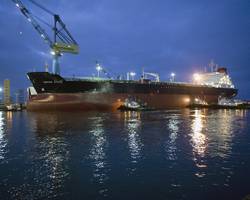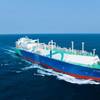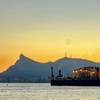West Coast Maritime Action
While maritime activity showing renewed signs of life along the entire Pacific Coast, from Prince Rupert to San Diego, shipbuilding is becoming ever-more dependant on the US Navy and Jones Act ships, while ship-repair yards are focused on a broad spectrum of boats and ships. In California, some of that work has focused on re-powering harbor craft to meet the state’s stringent environmental regulations. Along the Columbia River, shipyards remain centered on meeting the on-going demand for ocean-going barges, while Puget Sound shipyards continue to focus on aluminum high-speed boats and catamarans. And there is some logic to that, since the region is the site of the major hydro-electric power plants that provided the low-cost power for an expanding aluminum industry.
Todd Pacific
An exception to that trend is the venerable Todd Pacific yard in Seattle with associated yards in Bremmerton and Everett, Washington. We talked with marketing director, John Lockwood, who noted that, “We will be building automobile ferries for Washington State Ferries for quite a while,” with one ferry about to be delivered, work started a second one, a third under contract, and an option to build for a fourth one.” These are steel-hull, 64-car ferries with aluminum superstructures built by Nichols Brothers, since Todd does not do work in aluminum. Lockwood also pointed out that “We are also doing a lot of work on Coast Guard ice-breakers. The 410-ft Healy just left the yard after several months of upgrade and repair work. The 399-ft Polar Star is being re-activated, and the Polar Sea will be in the yard shortly for an extended availability.
“We are also doing a lot of work on fishing vessels, and over in Bremerton, we continue to work on aircraft carriers. We have a five-year contract with the Navy to perform non-nuclear work on the CVN-68 Aircraft Carriers.”
NASSCO, the San Diego Shipbuilder for the Navy
Navy ships also continue to figure prominently in the work of NASSCO, the largest shipbuilding yard on the US West Coast, with a work force of some 4,200 workers. A subsidiary of General Dynamics Corp., the yard dates back to World War II when it became a part of the Kaiser group of companies that, among other activities, built wartime ships.
At NASSCO, we talked with Bryan Ruiz, manager of governmental shipbuilding, who stressed that, “Right now, we are going gangbusters on the Navy’s dry-cargo/ammunition vessel or TAKE program. We recently got a contract for #13 and #14, the last two ships of that class, which will provide work for the yard through 2012. In addition, we are beginning work on the MLP, a mobile landing platform vessel. It is essentially a heavy lift vessel, based on our BP tanker design, except that the tanker space will be transformed into a flat deck for lifting and staging equipment from other vessels.”
Dave Baker, manager of commercial shipbuilding, commented that, “We have been building five product carriers. They are basically 43,000 dwt tankers with 12 main tanks for a wide variety of liquid cargos. Three have been delivered, and we have two more to go, with the last to be finished at the end of the year. Then, our work force can be transferred to government work until we pick up our next commercial contact.” Baker continued, “Three of the ships are currently operating with oil companies, and the final two are going to go under charter to the Military Sealift Command.” We asked, “Where do you go from here?” and the answer was, “It all depends on the market for Jones Act ships. We are constantly looking for new business.”
Among new business leads that NASSCO is pursuing is MARAD’S Marine Highway Program with research undertaken by a full-time Manager of Government Relations resulting in the recent publication of an impressive volume entitled, “A Shipbuilder’s Assessment of America’s Marine Highways.”
BAE, Ship Repair in San Diego and in San Francisco
Another major defense contractor, BAE, operates ship-repair yards in San Diego and San Francisco, as well as in Hawaii. We talked with Bob Kilpatrick, general manager of the San Diego Yard, whose first comment was, “We have a lot of work going on, with a payroll of as many as 1600 people!” and explained, “Our San Diego yard, in conjunction with the three other nearby master ship-repair contractors for the US Navy … NASSCO, Northrop-Grumman, and Continental Maritime … is engaged in major modernization programs for the US Navy’s cruisers, destroyers, and LSD-41 class ships.” The program for cruisers, currently underway, comprises a six-month mechanical modernization program, followed an electronic overhaul in a second six-month period.
Kilpartick noted that, “In June, we will be starting a modernization program for the USS John Paul Jones, as the beginning of the Navy’s destroyer modernization program.”. The program for destroyers is huge, involving over 50 ships built some 20 years ago and bringing them up to the standard of brand-new ships with an additional 20 years of active duty. BAE’s San Diego yard, along with the other ship-repair contractors in the area, is also providing “post-shake-down services” for an ongoing stream of new Navy ships, which adds up to a very busy ship-repair load.
At the venerable BAE San Francisco Drydock, the focal point is the 900x150-ft floating drydock, the largest on the US West Coast, and the only one capable of servicing many of the cruise ships calling at the Port of San Francisco. The yard has a second floating drydock, measuring 528x90-ft. These two drydocks are the only ones on the bay capable of cleaning the hulls of many of the old ships from the US Maritime Administration’s (MARAD) Reserve Fleet, prior to their being towed to yards in Texas for scrapping. BAE is definitely not prepared or equipped to scrap these ships at its yards in environmentally-conscious California, but it does power-wash them, clean the hulls of invasive species, and inspect them, prior to their being towed to Texas. As of May 1, the yard has cleaned six of the more than 50 MARAD ships in the Reserve Fleet.
Among recent ships repaired at BAE’s San Francisco Drydock are Coast Guard cutters, cruise ships, barges, a Matson container ship, and the hospital ship, USNS Mercy. The yard employs some 300 workers.
Bay Ship & Yacht, the Other Shipyard on the Bay
The only other shipyard of note on San Francisco Bay is Bay Ship & Yacht in Alameda, which provides repair and maintenance services for the diversified array of workboats on the bay including the growing fleet of ferries and excursion boats. The yard has developed an expertise in aluminum metalworking and believes that it could build the Bay Area’s high-speed aluminum ferries that are now built in the State of Washington. Traditionally Bay Ship & Yacht has played an essential role in maintaining the historic ships at the Ntional Park’ Hyde Street Pier in San Francisco.
Bay Ship & Yacht has a work force of about 250, with facilities that include 1,000 ft of waterfront dredged to 42-ft, two outfitting docks, a 390-ft floating drydock, a 1,200-ton/200-ft Syncrolift and transfer system for seven 200-ft vessels on land, and an array of diversified shops.
As for the ships in MARAD’S Reserve Fleet, its facilities should be able to handle the cleaning of some of the smaller ships, although the yard has not participated in solicitations up to this point.
MARAD Settles Litigation on Reserve Fleet
In the years following World War II, the US Maritime Administration (MARAD) acquired ships for a “Ready Reserve Fleet” that would be available for national emergencies, and the Korean War proved to be such an emergency. But, MARAD continued to acquire more and more ships for its fleets on the East Coast, the Gulf Coast, and the Pacific Coast where scores of ships remain anchored in Suisun Bay, a part of San Francisco Bay.
As the years passed, it became obvious that many of the old ships were less and less capable of playing any role other than fodder for ship-scrapping yards. But, with a limited budget, MARAD initially began disposing of its ships from its East Coast and Gulf Coast fleets, by towing them to scrapping yards in Texas. Since there are no ship-scrapping yards on the Pacific Coast, the ships from California not only had to be towed down the coast and through the Panama Canal to Texas, but also required intensive hull cleaning to prevent the transfer of invasive species to Gulf waters. The budget for hull cleaning and towing amounted to more than $2 million for each ship, while ship-scrapping could add another $1 million, depending on the price of steel scrap. Ships from MARAD’S other two yards could be scrapped for half that cost, thus leaving the old ships in California waters essentially stranded, with the state and the environmental community fuming and finally taking MARAD to court.
One of the litigants in the legal case concerning the disposal of MARAD’s Suisun Bay fleet was California’s Water Regional Quality Control Board, San Francisco Bay. We talked with its chief, Bruce Wolf, who explained, “First MARAD is required to file a permit for the existing 57 ships in the fleet. Within 120 days they must compete the cleaning of the decks of all of the ships and then clean the sides of the ships down to the waterline. The first 25 ships must be disposed by 2012 and remained of the ships by 2017.
Ship Scrapping at the former Mare Island Navy Yard
”There is a provision in the Water Quality Control Board’s agreement with MARAD that, if the ships could be disposed of in San Francisco Bay, they could take the ships directly to that disposal site. Right now work is being done to reopen the old drydocks at the Navy’s former shipyard at Mare Island, only a few miles from the site of the reserve fleet. MARAD is supportive of that, because it would save the cost of towing the reserve fleet ships to Texas, which costs about $1 million per ship. It would cost about half as much at Mare Island.
“The Water Quality Control Board actually issued a permit for re-opening the two dry-docks at Mare Island a couple of years ago. There are four drydocks at Mare Island, but the two in question measure 88 by 680 ft and 84 by 650 ft. The present problem is that, while the drydocks are functional, a lot of sediment has built up against the drydock doors. So, now the issue is getting the dredging permits and determining where the dredge material can go. But, there is optimism that the permits will be in place this Summer.”
We talked with retired Navy Officer Gary Whitney, who established a firm Allied Defense Recycling LLC to restore and operate the Mare Island Drydocks. He emphasized that, “We have asked for a dredging permit no later than 30 May with a target for dredging to start on 02 Aug. If everything goes as planned, we should by open sometime this Summer and be operational this Fall. Then, we will enter into negotiations with MARAD for the ship disposal program. We will also be negotiating with MARAD for master ship-repair contracts. It is my intent to have a full service shipyard at Mare Island, probably called Mare Island Shipyard (MISY).”
MARAD’s Marine Highway Program, a New Market for Shipbuilders?
A spokesperson for NASSCO commented that “We are interested in the Marine Highway concept as a potential market and a means of adding an additional mode to our national transportation system.” NASSCO has studied the concept extensively and prepared a report entitled, “A Shipbuilder’s Assessment of America’s Marine Highways.” That report concludes that “An economical, effective Marine Highways network could serve as a potential new and substantial market for U.S. shipyards … through series production and by leveraging recent experience gained through international collaboration.” The report calls for the removal of the Harbor Maintenance Tax on domestic cargoes, and points to proposed vessels that could range from container-on-barge to Roll-on-Roll Off vessels, to Ro-Pax vessels.
MARAD Awards “TIGER” Grants for California Marine Highway Project
Earlier this year, MARAD announced a series of Transportation Investment Generating Economic Recovery Grants, or TIGER grants, that included $30 million for what has been termed the $69.3-million California Green Trade Corridor/Marine Highway Project. As proposed, it would link the Port of Oakland with the inland ports of West Sacramento and Stockton with a barge system that would reduce the present heavy highway congestion between Oakand and the inland ports. A second round of TIGER grants is expected later this year.
Mike Lukens, director of the Port of West Sacramento, commented “we first need to develop a memorandum of understanding between the three ports regarding the project” and noted that this initial grant is expected to be used largely for an environmental assessment and an investment in shore-side cranes and other infrastructure.
Bill Lewicki, marketing director for the Port of Stockton, noted that the Green Trade Corridor program could develop into a lot more than a barging program between the inland ports and Oakland. He commented that, “Right now we can barge to Portland-Seattle or to Los Angeles-Long Beach and that is where the future is looking.”
Both ports noted that the Denver-based shortline-railroad investing firm, Broe Group, had been in contact with them. Earlier this year, it was reported that the Broe had established a firm called Eco-Transport, a short-sea shipping venture that, according to its website, “moves your containers on barges between the Ports of Oakland and Stockton.” The Port of Oakland declined to comment.
















